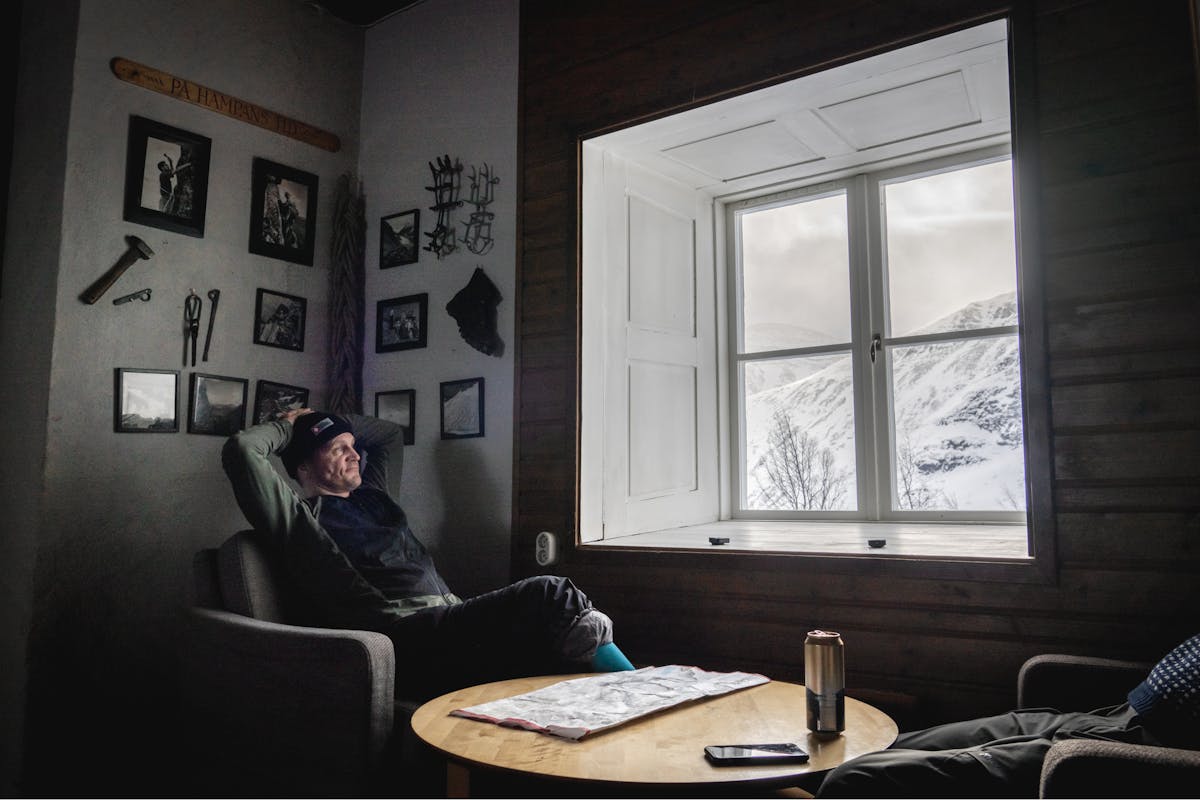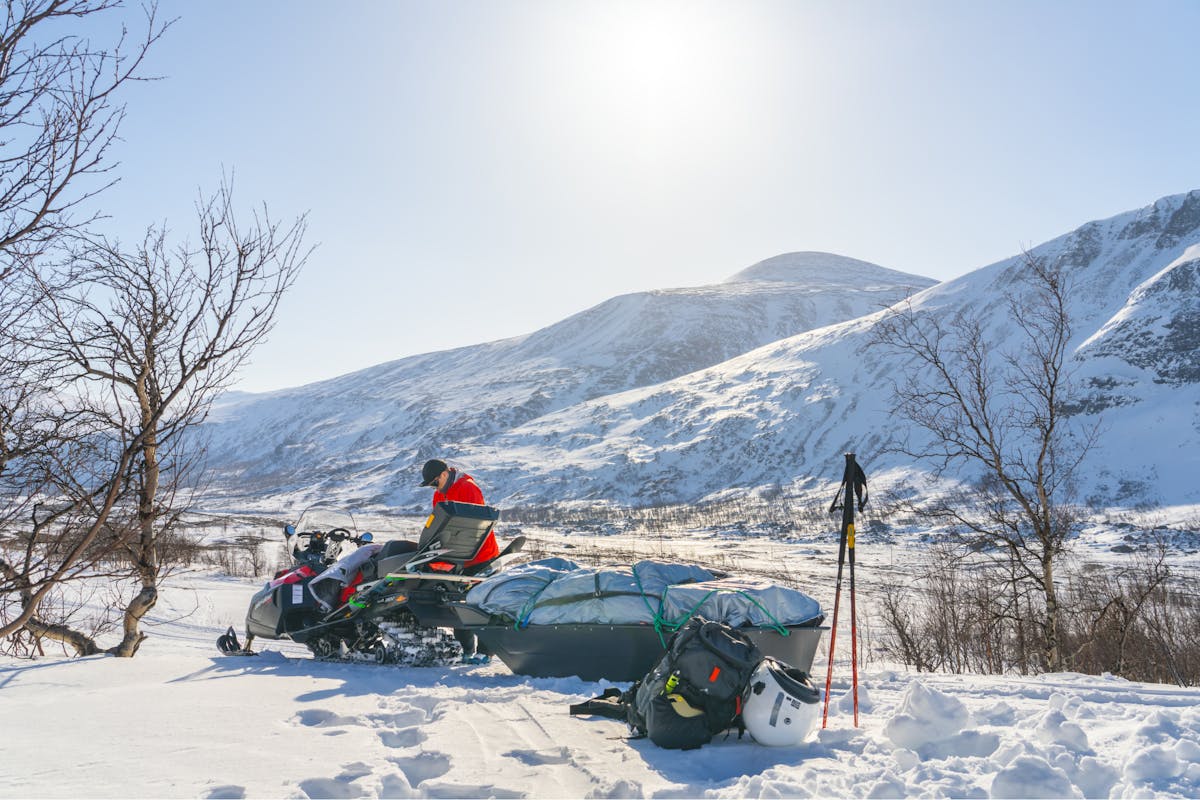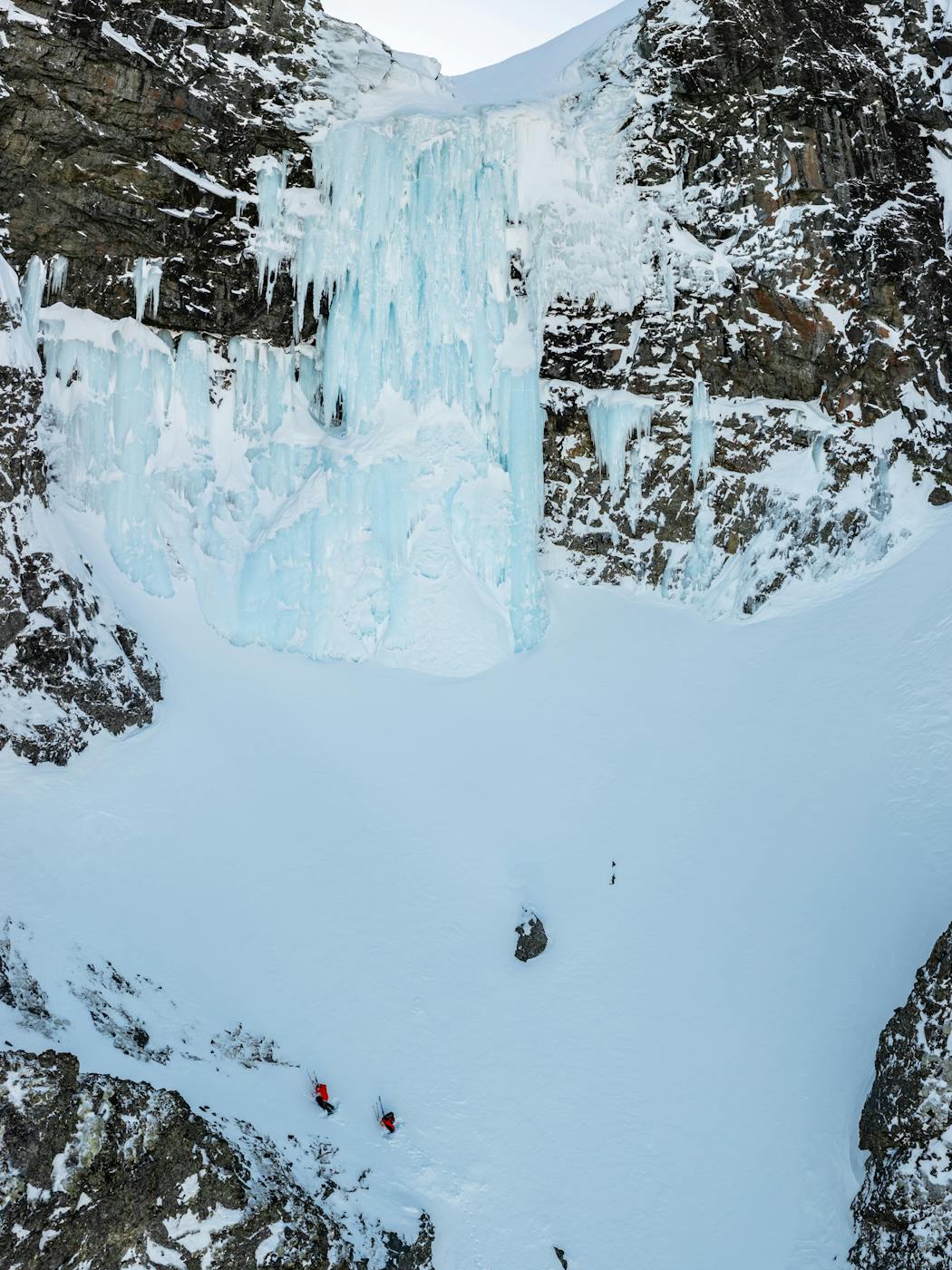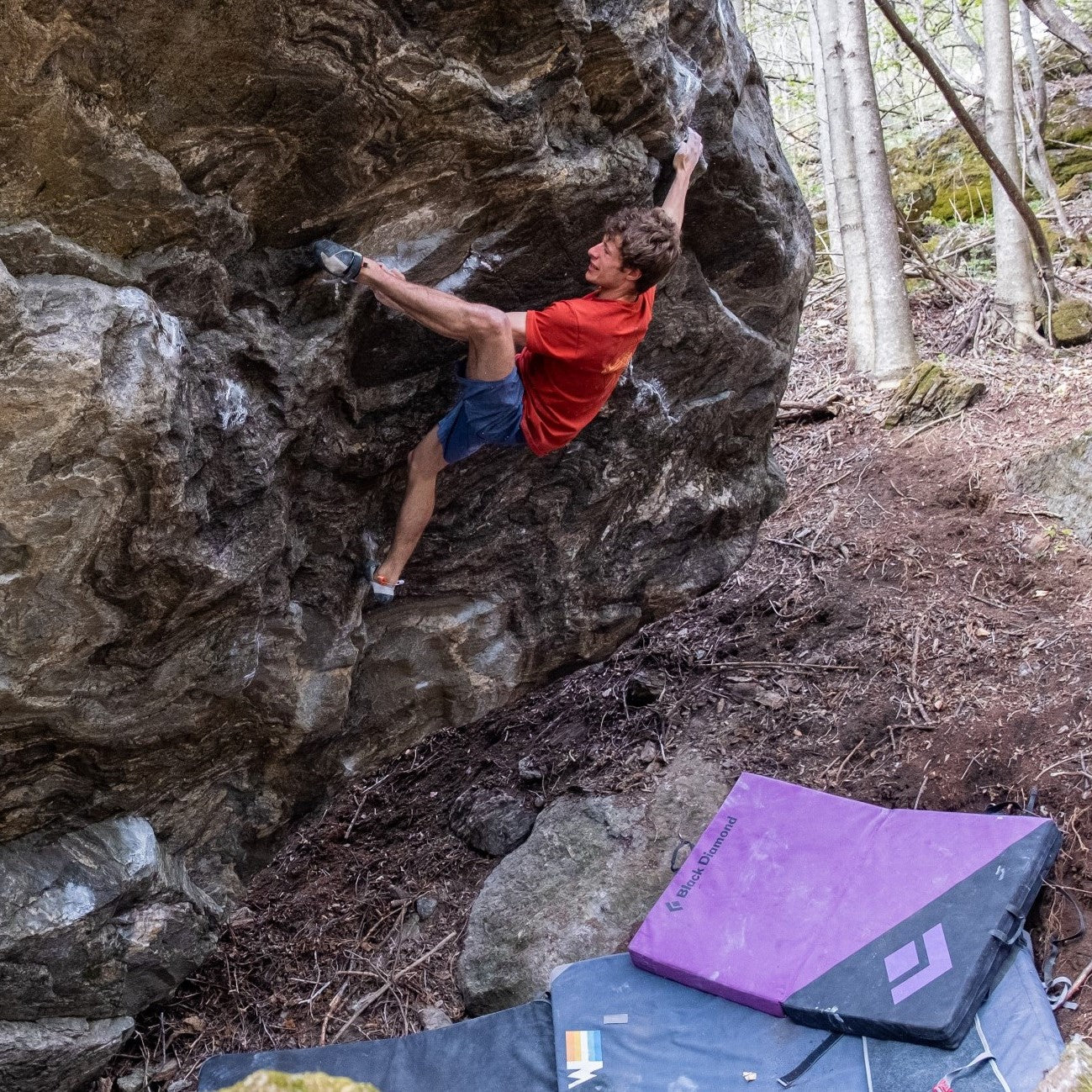
WHAT TO WEAR BACKCOUNTRY SKIING
Dial in your kit for the skin track.
Add 100 EUR more to quality for free Shipping!
€0,00 EUR
TUESDAY, OCTOBER 15, 2024
Kebnekaise is in Sweden at the 67th latitude, west of the town of Kiruna. The mountain's peak is 2,094 meters above sea level. The surrounding area of Kebnekaise is characterized by northern mountainous terrain. Glaciers descend into the valleys from the peaks, and the valley landscapes are dominated by birch forests and large lakes further below. The Kebnekaise area is part of the Scandinavian Mountains, which cover a large portion of Norway's coastline. The mountain range extends from the Norwegian coast into Sweden, where small mountainous areas are separated by deep valleys.
The area offers excellent skiing, but rapidly changing conditions, cold weather, and remote location make skiing challenging. Skiers must be prepared for quickly changing weather and cold conditions. Precipitation levels vary yearly, but overall, there is less snow in the area than on the coast. The low amount of snow makes the snow cover unstable, and the region often experiences large avalanches due to the problem of a weak layer persisting for a long time. Skiers must be prepared for this uncertainty and take it into account when planning.
Antte Lauhamaa: Skiing Kebnekaise
I have been familiar with the Kebnekaise area since 1998 when I participated in the Kebnekaise Classic ski touring competition held there. At that time, there was a lot of snow, and I remember skiing in knee-deep powder. Now, there is less snow, but we knew there would be enough for our needs.
We camped about 20 kilometers from the road. The three of us traveled on a single snowmobile, on which we had packed everything needed for a week. A snowmobile route passes by Kebnekaise, which was in excellent condition and could be driven easily despite the heavy load. The route starts from the village of Nikkaluokta. The mountains surrounding Kebnekaise appeared to us in clear weather as we approached the area, and in the evening glow, they looked magnificent. Once we arrived, we set up the tent and the stove, which would provide warmth during the evenings after long days. As we went to bed, the Northern Lights cast a green glow over the surroundings.
In the early morning, it had started to snow, and by the time we woke up, 20 centimeters of new snow had already accumulated. The sky was cloudy, and visibility upward was only a few hundred meters. Nevertheless, after breakfast, we decided to go out, assess the snow cover for the coming days, and hope that the weather would clear.

In the early morning, it had started to snow, and by the time we woke up, 20 centimeters of new snow had already accumulated. The sky was cloudy, and visibility upward was only a few hundred meters. Nevertheless, after breakfast, we decided to go out, assess the snow cover for the coming days, and hope that the weather would clear.
As we climbed higher, we quickly realized that the local avalanche forecast was accurate. The lower snow cover had almost completely melted and refrozen, and the new snow that had fallen on top of it was unpacked after a calm night. The descent would be perfect if only we could see around us.
Around midday, the clouds began to break, and Mikko and I decided to climb up a nearby couloir. We had left the crampons at the tent, as we hadn't expected the weather to clear so quickly. This proved to be a mistake in the upper part of the couloir, where the snow cover was so icy under the new snow that it was difficult to plant the tip of the boot into it. However, we managed to continue cautiously and found a suitable starting point between the rocks.

As we were putting on our skis, the weather had completely cleared, and the midday sun was shining warmly. We impatiently waited for the signal from our photographer, Rami, and checked the bindings for ice. The first turn felt amazing, and I saw how the surface avalanche on the new snow quickly fell behind as we picked up speed. The Helio 115 began to float on the new snow, and I looked ahead for the spots for the next turns. At the bottom, we had a snack and climbed to the top of a nearby couloir, which we could ski in the afternoon sunshine. "What a perfect start to the trip," we said as we skied back to the tent.

In the evening, we checked the weather forecast, which predicted rapidly deteriorating weather. The wind would start blowing from the northwest at night, and unstable weather would continue for a few days. That night, we confirmed that the forecast was accurate. The wind began to shake the tent, and I put earplugs in for the rest of the night.
The morning revealed what we had feared. The wind had been so strong overnight that most of the newly fallen snow had disappeared, leaving behind old frozen snow and new snow formed into wind slabs. We reviewed our options, looking for areas where dangerous amounts of wind slabs would not have formed. We decided to head toward the Björklings Glacier and reassess the situation once we got there.
As we ascended toward the glacier, we realized that, despite our hopes, the wind had completely ruined the snow. Under our skis, there was a breakable crust with powder snow from the previous snowfall underneath. The crust had formed everywhere, and we knew that skiing would be a secondary concern for the day. We navigated carefully, avoiding avalanche terrain. There were no signs of larger avalanches, but small wind slab avalanches were very likely in these snow conditions if we were in the wrong place.
On the glacier, we checked the time and looked at the weather forecast. We would have time to reach the top of Kebnekaise if we kept moving and used the fixed ropes on the Östra leden climbing route.
We were the only climbers on the Östra leden that day, and the ascent went quickly. On the summit ridge, the wind was extremely strong, and we saw a cloud front rapidly approaching us from the east. We decided to stop at the top stuga near the summit and quickly eat our snacks. On our way back, the wind began to strengthen, and more clouds started to gather. We skied back to the starting point in flat light and extremely difficult snow. The breaking crust made the descent so challenging that Mikko and I agreed that it was the worst snow we had skied in years. We laughed about it and skied back to the camp.
At the tent, we met Rami, who had returned there before us. He told us he had been filming our ascent with a drone, which had not returned. It had disappeared, and he no longer had a drone for filming.
While preparing food, Rami investigated the possibility of getting a new drone. By the time dinner was ready, he had arranged for a new device to be delivered to Kiruna the next day. We agreed that I would take Rami to the roadside, and he would go to Kiruna during the day. The weather forecast promised sunny weather, and Mikko and I planned to do a long ski tour through the glaciers to the Tarfala Research Station located in another valley.

We started the snowmobile early in the morning, and I returned to Mikko, who had prepared breakfast. After breakfast, we packed the glacier equipment in our backpacks and set off. The morning weather was better than forecasted, and we sweated in the sunshine as we ascended towards Kebnetjåkka. We descended onto the glacier, and both noticed a steep slope descending from under the northern summit of Kebnekaise toward the glacier. We decided to check the snow conditions there. If we were lucky, we might be able to ski down the slope, at least partially

We cautiously moved towards the lower part of the slope. I dug a snow pit and performed an ECT test with no results. I dug another snow pit slightly higher up, again with no results. We concluded that the sun had warmed the surface layer of snow, which had bonded well with the lower layer. We put on crampons and started to ascend using a bootpack. We climbed about 250 meters in elevation and found shelter under a rock. We took the first turns cautiously, one at a time, as the slope was about 45 degrees steep from the start and the snow quality was a bit uneven. After the first turns, everything felt good, and we skied down to the junction of two glaciers, from where we continued further.
On the Storgläciär glacier, we decided to move roped up because some crevasses were visible due to the low snow cover. We continued towards Tarfala, where we replenished our water supply at the research station. From Tarfala, we mostly skied back the eight kilometers to the tent. At the end of the afternoon, I went to pick up Rami from the roadside. The new drone had been picked up, and we could continue filming.

The next day, the wind had picked up again, and now its strength was close to a storm. We drove along the valley on a snowmobile, trying to find a suitable target for the weather. We had to turn back at 900 meters altitude when visibility became so poor that the terrain could no longer be reasonably assessed. Similar weather continued for another day, and we could not ascend higher. The snow had turned icy due to the wind, and there was no soft snow anywhere.
After two days, we had found an interesting spot that both Mikko and I wanted to ski. The place was closer to the road, and we had seen it on our way in. It was a dog-leg-shaped couloir starting below an icefall, and the weather for the day would be perfect to attempt to ski it. In the afternoon, we climbed the couloir in icy snow and looked around. As we ascended higher, the icefall began to take shape as a massive green-blue pillar rising straight from the couloir. We paused for a moment, admired the scene and listened to the silence. Here, in frozen form, was the very reason why venturing into the wilderness is worthwhile. Such an experience couldn't be had in any other way, and nothing could be more magnificent right now. We locked our bindings for safety, as the snow was hard and icy. With controlled and calm turns, we skied down towards the snowmobile waiting by the lake.
The crew: Antte Lauhamaa, Mikko Lampinen, Rami Valonen.


Follow BD Athlete Yannick Glatthard deep into the Swiss Alps as he shares his home...
Follow BD Athlete Yannick Glatthard deep into the Swiss Alps as he shares his home mountains with close friends.

Follow Dorian Densmore and Mya Akins for another winter season of steep Alaskan spines, backyard...
Follow Dorian Densmore and Mya Akins for another winter season of steep Alaskan spines, backyard couloirs, and deep adventures in the mountains.


Watch BD Athlete Alex Honnold throw down on some hard trad high above Tahoe.



In 2012, filmmaker and photographer Ben Ditto, and professional climber Mason Earle equipped an immaculate...
In 2012, filmmaker and photographer Ben Ditto, and professional climber Mason Earle equipped an immaculate line in Tuolumne’s high country. But their attempts to free the route were thwarted when Mason’s life changed drastically. With the help of Connor Herson, Ditto and Mason found a way to keep the dream alive.



Watch and learn as our Field Test Coordinator runs you through a step by step...
Watch and learn as our Field Test Coordinator runs you through a step by step process of trimming and setting up any STS-style Black Diamond skin.


Every climber has a few lines they dream about. Whether inspired or haunted—or sometimes both—these...
Every climber has a few lines they dream about. Whether inspired or haunted—or sometimes both—these lines can push us beyond what we thought we were capable of, in turn teaching us who we really are. BD Ambassador Ethan Salvo recently restructured his entire life to focus on two climbs that pulled him into the void with only one way out … getting to the top. This is his story of sending Dreamcatcher and becoming the first Canadian to climb V16 in the same week.

BD Athlete Connor Herson spent as many weekends as possible in the Valley this spring...
BD Athlete Connor Herson spent as many weekends as possible in the Valley this spring during a grueling quarter at Stanford. The objective? Ground up, in-a-day ascents.
